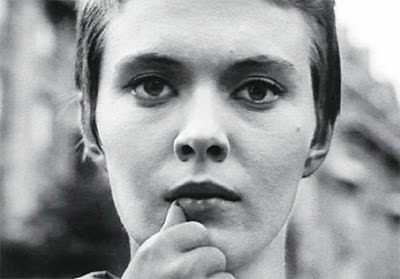
Breathless' ending is iconic, but it's also enigmatic. In the last minute of the movie, Michel lays dying while the police and Patricia stand over him. Looking at Patricia, he mutters "It's disgusting" and dies. When Patricia asks the detective Vital what Michel said, he incorrectly replies "He said 'You're disgusting.' " Whether or not Vital intentionally misrepresents Michel's dying words to Patricia is a matter of conjecture. However, his statement prompts Patricia to stare directly into the camera and move her thumb across her lip, a gesture made famous by Humphrey Bogart and frequently imitated by Michel in the film. What does it mean? Who knows? I'm not sure it ultimately matters.

"Life's a bitch and so am I???"
Breathless belongs to a class of 1960s European art films that treated the sensational aspects of modern life – crime, sex, violence, etc. – in a disjointed and abstract way. Like Antonioni’s Blow-up (1964), Breathless is full of bohemian touches, avant-garde style, and a philosophical preoccupation with ennui, a pervasive force in 1960s Europe. The film is considered to be the fountainhead of the French New Wave movement, about which I know absolutely nothing. However, if Breathless is any indication, I would imagine that the New Wave aesthetic is characterized by low-key lighting, frenetic, non-continuous editing techniques, stream-of-consciousness dialogue, minimal plotting, ambiguous symbolism, ambivalent characters, and philosophical concerns. The characters are also probably really well-dressed and followed wherever they go by hip jazz soundtracks.
Breathless borrows heavily from classic Hollywood crime films, but there’s a sharp contrast between Jean-Luc Godard’s style and the works of directors like Alfred Hitchcock. Hitchcock’s films are modern fantasies, ones that clearly cater to the audience’s desire for cinematic wish fulfillment. However, what makes Hitchcock’s movies so effective as thrillers is Hitchcock’s firm belief in the reality of guilt. He finds modern life exciting because he believes that, behind conventional behavior and day-to-day concerns, there are dark forces at work inside each and every one of us.
However, in Breathless guilty is an empty concept. The characters feel no guilt or remorse over illicit sex, petty crime, or even murder. As a result, there’s no suspense or excitement. Having casual sex or planning a getaway to Rome is more “exciting” than committing a murder or being a fugitive from the law. Here, the characters are only concerned with alleviating the boredom of everyday life and worrying about the vague finality of death.




No comments:
Post a Comment